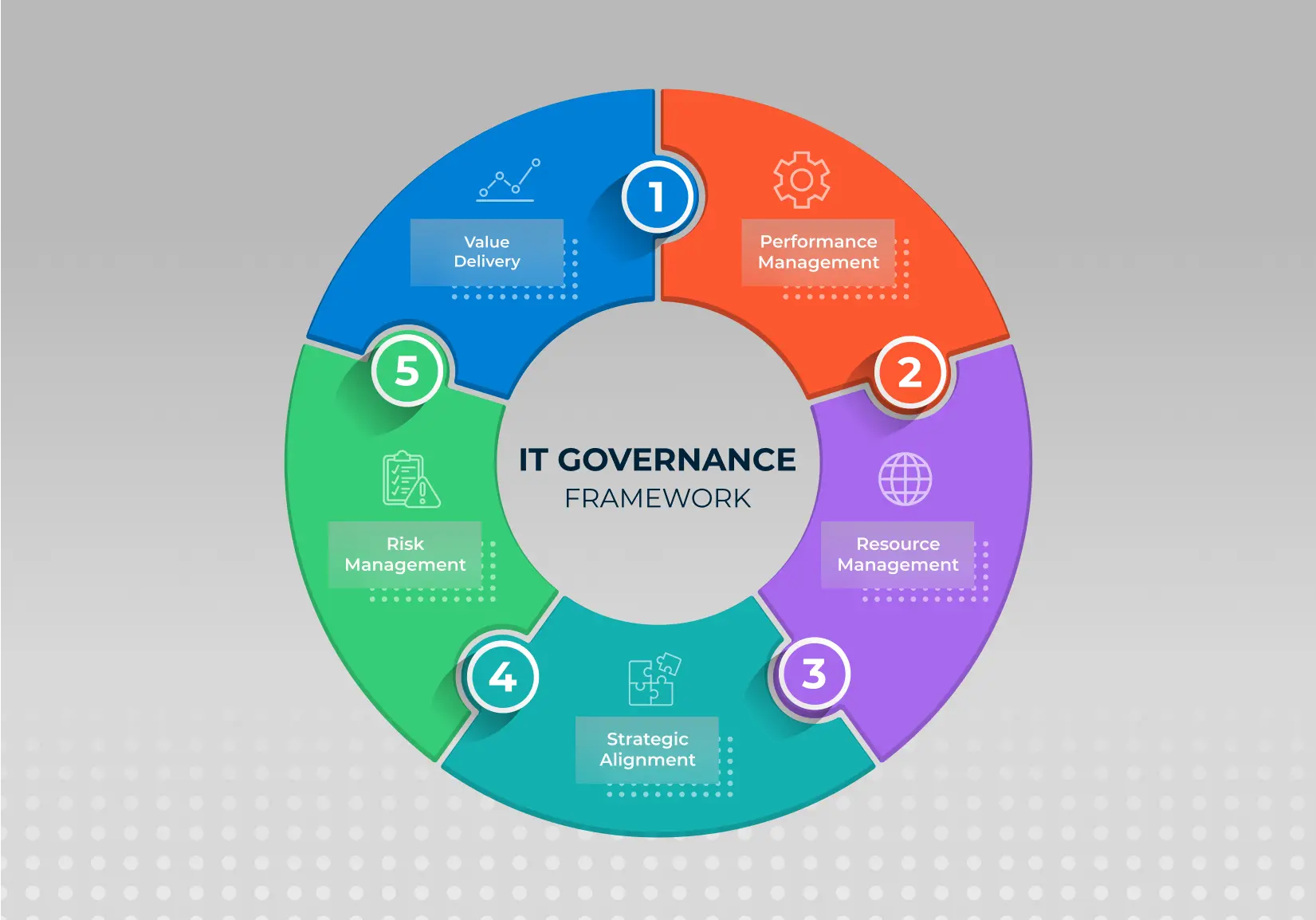Information technology has become ubiquitous in almost every sector and company worldwide due to the increasing importance of data analysis and essential IT resources like software and hardware for the majority of businesses. Indeed, technology plays a pivotal role in achieving success and maintaining a competitive edge. But having the latest gadgets and gizmos isn’t enough. To truly conquer the digital rapids, businesses need a clear roadmap for managing their IT infrastructure – that’s where IT Governance (ITG) comes in.
What is IT Governance?
IT Governance is a structured framework that defines the processes, roles, and responsibilities necessary for managing an organization’s information technology resources. It ensures that IT investments align with business objectives, mitigate risks, and deliver value to the organization. Essentially, IT Governance serves as a bridge between an organization’s business goals and its IT infrastructure.
ITG originated in response to corporate scandals in the early 2000s, such as those involving WorldCom and Tyco, which prompted the enactment of the Sarbanes-Oxley Act. These incidents highlighted the need for organizations to manage their IT resources effectively and maintain transparency and accountability in their business practices. As a result, IT Governance frameworks emerged to help organizations align IT strategies with business goals, mitigate risks, and ensure compliance with regulations, becoming crucial tools in the digital age.
The 5 domains of IT Governance

The IT Governance Institute (a division of ISACA) breaks down IT governance into five domains. Incorporating these five domains into an organization’s IT Governance strategy helps ensure that IT resources are leveraged effectively, aligned with strategic objectives, and equipped to manage risks while delivering maximum value to the business. By addressing these domains comprehensively, organizations can navigate the complexities of the digital age with confidence and resilience.
1. Value Delivery:
Value delivery is a core domain of IT Governance that centers on ensuring that IT investments and initiatives provide tangible value to the organization. It involves:
- Business Value Alignment: IT should align closely with the organization’s strategic goals and objectives. Value delivery ensures that IT investments are directed toward projects and initiatives that directly contribute to business growth and competitiveness.
- ROI Measurement: Evaluating the return on investment (ROI) of IT projects is essential. IT Governance in the value delivery domain includes methodologies for measuring and optimizing ROI, ensuring that resources are allocated to projects with the highest potential for delivering value.
- Benefits Realization: Beyond the planning stage, value delivery also focuses on realizing the expected benefits of IT projects. It involves monitoring and tracking project outcomes to ensure that they align with the initially defined goals and objectives.
2. Strategic Alignment:
This domain emphasizes the importance of aligning IT strategies with the overall business strategy. It encompasses:
- Strategic Planning: IT Governance in the strategic alignment domain involves the development of IT strategies that are closely integrated with the organization’s long-term strategic plans.
- Communication and Collaboration: Effective communication and collaboration between IT and business units are essential for ensuring that IT initiatives support the organization’s strategic objectives. Strategic alignment facilitates these interactions.
- Portfolio Management: IT Governance frameworks often include portfolio management processes, which help prioritize and manage IT projects to ensure that they are aligned with the organization’s strategic priorities.
3. Performance Management:
Performance management within IT Governance focuses on optimizing the efficiency and effectiveness of IT operations. It includes:
- Key Performance Indicators (KPIs): Establishing and monitoring KPIs helps organizations assess the performance of IT processes, services, and projects. This data-driven approach aids in identifying areas for improvement.
- Continuous Improvement: The performance management domain promotes a culture of continuous improvement within IT. Regular assessments, benchmarking, and feedback loops enable organizations to enhance their IT capabilities over time.
4. Resource Management:
Effective resource management is crucial for optimizing IT operations while managing costs. This domain encompasses:
- Resource Allocation: IT Governance frameworks provide guidelines for allocating resources, such as budget, personnel, and technology assets, to ensure that they are used efficiently and effectively.
- Capacity Planning: Resource management includes capacity planning to ensure that IT infrastructure can handle current and future demands. This proactive approach prevents bottlenecks and downtime.
5. Risk Management:
Risk management is a fundamental aspect of IT Governance, given the increasing complexity and security threats in the digital landscape. This domain includes:
- Risk Assessment: Identifying and assessing IT-related risks, including cybersecurity threats, data breaches, and compliance risks, is a key component. It helps organizations understand and prioritize risks.
- Mitigation Strategies: Implementing strategies to mitigate identified risks is essential. Risk management in IT Governance includes establishing controls, policies, and incident response plans to reduce exposure to potential threats.
The ITG Frameworks Your Business Needs to Know:

There’s no one-size-fits-all approach to ITG. Like choosing the right coffee roast, you need to select the approach that suits your organization’s size, industry, and risk profile. Here are some popular options:
- COBIT: This widely recognized framework provides guidance on aligning IT with business needs and best practices. It offers a range of processes and tools to help organizations improve their IT governance maturity.
- COSO: This framework emphasizes enterprise-wide risk management and corporate governance principles. It applies to all aspects of the organization, including IT, and helps businesses identify, assess, and manage risks effectively.
- ISO/IEC 38500: This international standard provides best practices for corporate governance of IT. It outlines principles and recommendations for establishing, implementing, and maintaining effective IT governance practices.
- CMMI (Capability Maturity Model Integrity): This model helps organizations improve their IT security practices through a five-level maturity framework. It provides a roadmap for organizations to assess their current state, identify areas for improvement, and implement best practices.
- FAIR: This framework helps organizations quantify and prioritize information risks. It provides a methodology for calculating the financial impact of potential data breaches and other security incidents, which can help businesses make informed decisions about allocating security resources.
- BSC (Balance Scorecard): This framework helps translate strategic objectives into measurable goals and KPIs. It can be used to develop IT goals that align with the overall business strategy and track progress towards achieving those goals.
Why Do Businesses Need an IT Governance Strategy?
Now let’s dive deep into the compelling reasons why having a robust IT Governance strategy is no longer optional, but essential for sustainable success:
- Alignment with Business Goals: An effective IT Governance strategy ensures that every IT investment and decision directly contributes to the realization of strategic goals. Without this alignment, businesses risk wasting resources on IT projects that don’t provide a clear business value.
- Risk Mitigation: The digital landscape is fraught with risks, including cybersecurity threats, data breaches, and compliance challenges. Businesses need IT Governance to proactively identify and mitigate these risks. Through structured risk assessments, security protocols, and compliance frameworks, IT Governance helps protect an organization’s sensitive data, its reputation, and its ability to operate securely in a constantly evolving threat landscape.
- Resource Optimization: IT resources are often among the most significant expenses for businesses. IT Governance ensures that these resources, including budget, hardware, software, and personnel, are allocated efficiently and used effectively. Without a clear strategy, businesses can overspend on unnecessary IT infrastructure or underutilize valuable assets, leading to financial inefficiencies.
- Transparent Decision-Making: An IT Governance strategy promotes transparent and accountable decision-making processes within an organization. It establishes roles, responsibilities, and decision-making frameworks that ensure IT-related decisions are made with clarity and consensus. This transparency reduces the likelihood of conflicts, miscommunication, and ineffective resource allocation.
- Performance Measurement and Improvement: In the absence of IT Governance, organizations may struggle to measure the effectiveness of their IT initiatives. IT Governance introduces performance metrics and Key Performance Indicators (KPIs) that allow businesses to assess the success of their IT projects and services. It enables data-driven decision-making and provides insights for continuous improvement, helping organizations stay competitive and agile.
- Compliance and Legal Obligations: Regulatory requirements related to data privacy, security, and industry-specific standards are becoming increasingly stringent. Businesses are obligated to comply with these regulations, or they may face legal consequences and reputational damage. An IT Governance strategy includes compliance frameworks and processes that ensure the organization adheres to relevant laws and standards, safeguarding against costly legal issues and fines.
- Competitive Advantage: Businesses that implement effective IT Governance gain a competitive advantage. They can adapt to technological advancements more swiftly, respond to market changes more effectively, and deliver higher-quality products and services to their customers. A robust IT Governance strategy positions a company as a forward-thinking and responsible organization, enhancing its reputation and market position.
- Stakeholder Confidence: Trust and confidence among stakeholders, including customers, investors, and partners, are vital for business success. An IT Governance strategy demonstrates an organization’s commitment to responsible and ethical IT practices. Stakeholders can be assured that their data is secure, their investments are well-managed, and their interests are protected.
Tips for IT Governance Implementation and Planning:
Implementing an effective IT Governance strategy requires careful planning and execution. Here are some tips to help you get started:
- Define Clear Objectives: Begin by setting clear objectives for your IT Governance strategy. What do you want to achieve? How will IT support your business goals?
- Involve Stakeholders: Engage key stakeholders from across the organization to ensure that IT Governance aligns with their needs and expectations.
- Choose the Right Framework: Select an IT Governance framework that best suits your organization’s size, industry, and specific requirements. Some commonly used frameworks include COBIT, COSO, ISO/IEC 38500, CMMI, FAIR, and BSC.
- Establish Roles and Responsibilities: Define the roles and responsibilities of individuals involved in IT Governance, including the IT Governance committee, IT managers, and other stakeholders.
- Develop Policies and Procedures: Create clear and comprehensive policies and procedures that outline how IT decisions will be made, how risks will be managed, and how compliance will be maintained.
- Monitor and Review: Regularly monitor and review your IT Governance strategy to ensure that it remains effective and adapts to changes in the business environment.
Overall, the pervasiveness of IT in modern businesses is undeniable. By embracing IT and its vast potential, businesses can unlock new opportunities, gain a competitive edge, and achieve sustainable success in the ever-evolving digital landscape.





